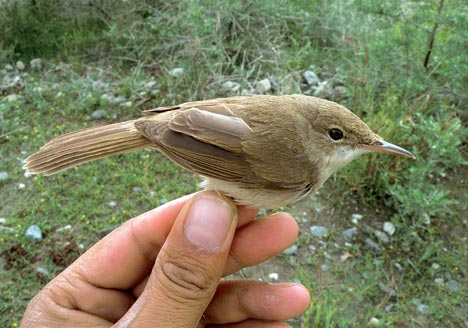
A large-billed reed warbler is captured, DNA profiled and released
July 18, 2010

A large-billed reed warbler is captured, DNA profiled and released
‘Lost’ large-billed reed warbler breeding site found
By Matt Walker
Editor, Earth News
A breeding site of the large-billed reed warbler has been found in Tajikistan by scientists.
The warbler has been described as the world’s least known bird; after a single specimen was found in 1867 the species was not seen again until 2006.
Since then a handful of live birds and museum specimens have been identified, and a possible breeding site found in Afghanistan.
But the new site is the first confirmed breeding location of the species.
Details of the new breeding site are reported for the first time in the Journal of Avian Biology.The first large-billed reed warbler (Acrocephalus orinus) was found in Himachal Pradesh, northwest India in 1867, though its validity was questioned for decades until DNA analysis this century confirmed it as a new species.
From 1867 till 2006, the bird was not sighted again in the wild, until a live bird was trapped in Thailand in 2006.
Two years later, the same individual was recaptured, as was another in another location in Thailand.
Little else was known about the large-billed warbler until 11 birds held in museums were also found to be of the species, some caught in Afghanistan in 1937 and one juvenile trapped in Kazakhstan in 1900.
These specimens suggested that the large-billed reed warbler might breed somewhere in the southeastern part of Central Asia.A wild large-billed reed warbler sings
Last year, a team of researchers believed they had discovered a breeding site of the enigmatic warbler in Afghanistan, after catching 15 birds which DNA analysis confirmed as Acrocephalus orinus.
However, they were not able to confirm that the species was breeding in the area, according to internationally agreed criteria.
Also, the researchers have yet to confirm the details of their find by publishing their records in the scientific literature.
Around the same time, ornithologists Dr Raffael Aye and Mr Manuel Schweizer of the Society for Field Ornithology and Bird Protection in Central Asia, and Dr Stephan Hertwig of the Natural History Museum in Bern, Switzerland found another significant discovery elsewhere in Asia.
The researchers discovered eight individual large-billed reed warblers living at three different riverine woodland sites in the Gorno-Badakhshan Autonomous Region of Tajikistan.Three new breeding sites of one of the world’s rarest birds, the Worthen’s sparrow of Mexico, were found in March this year
The Alaotra grebe is extinct, experts confirmed in May this year, the first confirmed bird extinction since 2008
They confirmed the birds are breeding at one, the first such confirmed breeding site of the species since its discovery by science.
“One of four adult birds caught in Vezdara displayed a large brood patch, suggesting that it was breeding,” explains Mr Schweizer, who is also a PhD student at the Natural History Museum in Bern.
“Also in Vezdara, two Acrocephalus warblers were observed around a group of bushes on 18 July and could be caught later and three rectrices on one tail side were taken for DNA analyses.
“On the 19th, they were again observed around the same bushes, this time missing rectrices on one side of their tails and feeding two fledglings.
“The fledglings were still extremely weak flyers and hardly able to fly from one bush to another.”
Although the team have been aware of the breeding site since last year, they have had to wait till now to publish details of their discovery in the scientific literature, and hence make it public.
See rest of article here, BBC News.
About Loren Coleman
Loren Coleman is one of the world’s leading cryptozoologists, some say “the” leading living cryptozoologist. Certainly, he is acknowledged as the current living American researcher and writer who has most popularized cryptozoology in the late 20th and early 21st centuries.
Starting his fieldwork and investigations in 1960, after traveling and trekking extensively in pursuit of cryptozoological mysteries, Coleman began writing to share his experiences in 1969. An honorary member of Ivan T. Sanderson’s Society for the Investigation of the Unexplained in the 1970s, Coleman has been bestowed with similar honorary memberships of the North Idaho College Cryptozoology Club in 1983, and in subsequent years, that of the British Columbia Scientific Cryptozoology Club, CryptoSafari International, and other international organizations. He was also a Life Member and Benefactor of the International Society of Cryptozoology (now-defunct).
Loren Coleman’s daily blog, as a member of the Cryptomundo Team, served as an ongoing avenue of communication for the ever-growing body of cryptozoo news from 2005 through 2013. He returned as an infrequent contributor beginning Halloween week of 2015.
Coleman is the founder in 2003, and current director of the International Cryptozoology Museum in Portland, Maine.
Filed under Avian Mysteries, Breaking News, CryptoZoo News, New Species